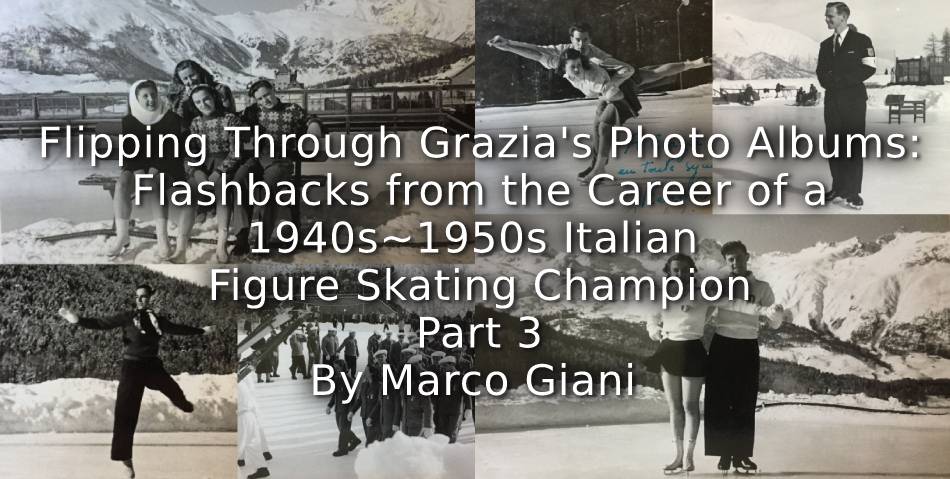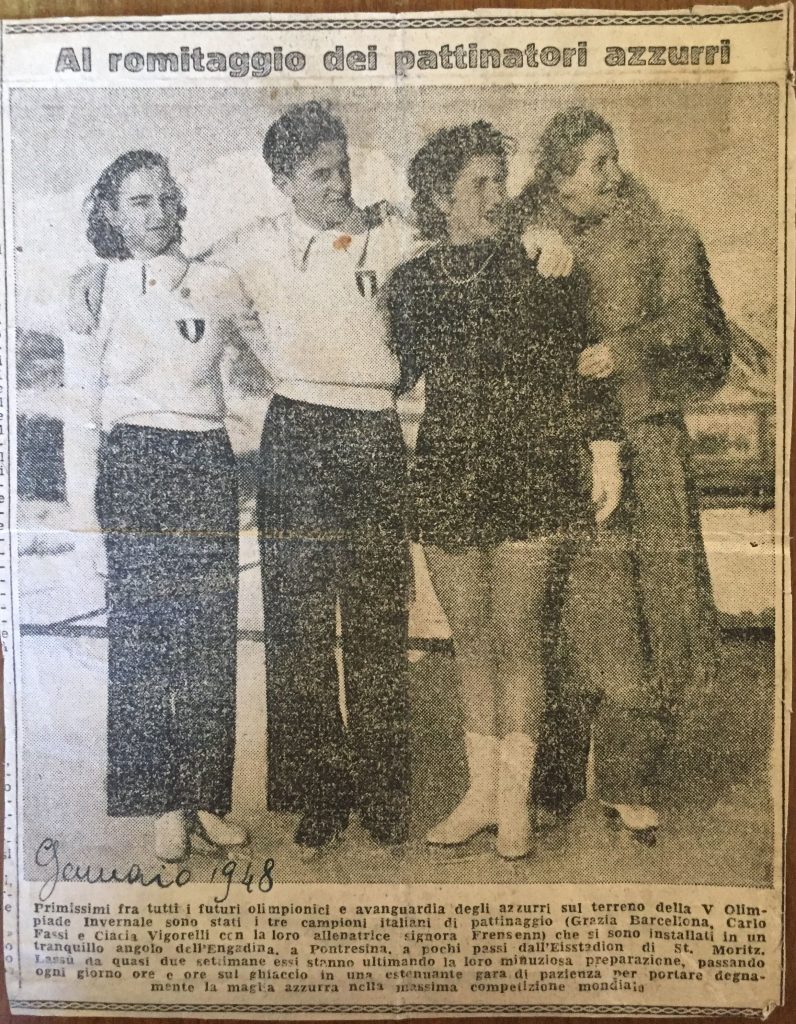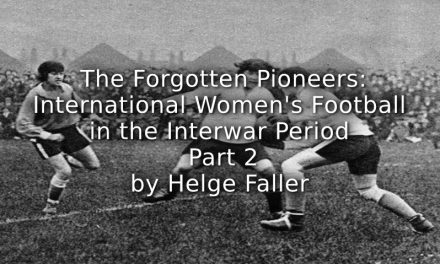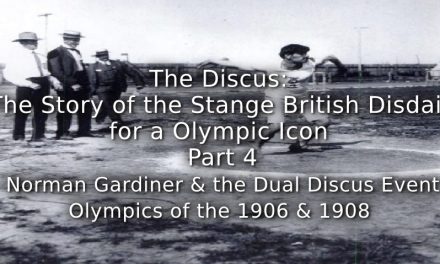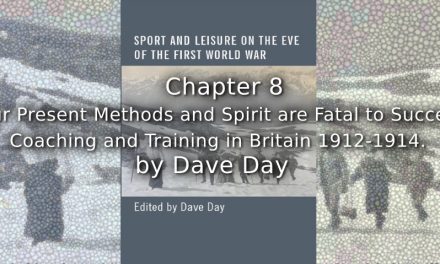PLEASE NOTE THAT ALL THE IMAGES IN THIS SERIES ARE THE COPYRIGHT OF MARCO GIANI AND ARE NOT TO BE REPRODUCED WITHOUT THE EXPRESS PERMISSION OF EITHER PLAYING PASTS OR THE AUTHOR
Special thanks to Rachel McNamara for the linguistic review and translation
To read earlier episodes of this series – Part 1 – bit.ly/33kXjz4 and Part 2 – bit.ly/325Zh4R
Part 3 concentrates on the Grazia’a second album, referred to as ‘The Brown Album’ and is dedicated to the 1948 Winter Olympics, held in St. Moritz, Switzerland. Grazia, who was still attending high school, was just 19.
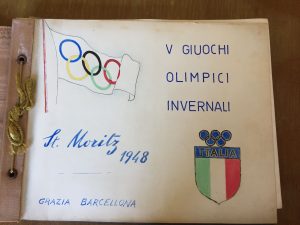
Title page of the ‘Brown Album’
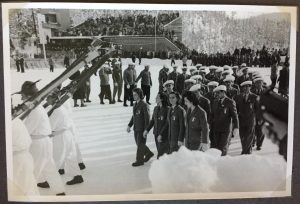
The 1948 Winter Olympics opening ceremony
Italy team placed its 4 female members in the front line, followed by the male athletes, wearing white berets
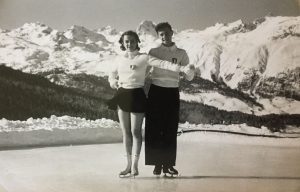
Grazia and Carlo in training, probably in Pontresina
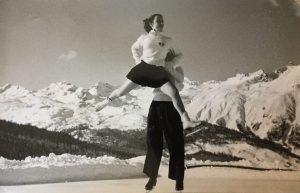
In St. Moritz, while competing at the Olympics, Grazia’s collection of autographed photos increased, with the world Goliaths of ice skating at the time all present …
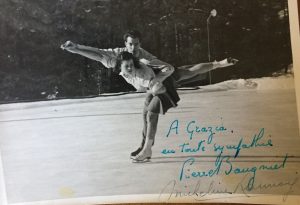
Belgian skaters Pierre Baugniet and Micheline Lannoy, gold medallists in pair figure skating
French caption says: “A Grazia, en toute sympathie, Pierre Baugniet Micheline Lannoy” [To Grazia, Kindly,Pierre Baugniet Micheline Lannoy]
Note the different ink of Micheline’s handwriting.
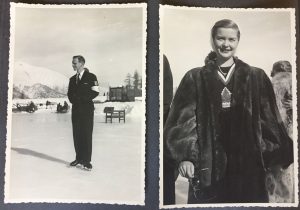
The singles figure skating gold medal winners
Richard Button [USA] and Barbara Scott [Canada]
The presence of Costanza “Ciacia” Vigorelli is a little bit of a mystery, in fact, she didn’t compete in any competition. According to Luigi [Grazia’s second son], Ciacia was in St. Moritz to take part in the single figure skating, while Grazia should compete in the pairs with Carlo, who would also compete in the male singles figure skating. But on the competition day Ciacia, after watching her opponents performances, refused to join the competition, so the Federazione Italiana Pattinaggio [FIP – ‘Italian Ice Skating Federation’] officers then decided Grazia was to take Ciacia’s place. This late substitution goes a long way to explaining why she was only placed 25th of 25 in compulsory figures and 24th in free skating.
Of course Luigi’s version, probably coming from his mother’s tales, needs to be verified. In the previous years Costanza was acclaimed by ice sports press, not only for her victories, but, it must be said, because of her social value. She was the daughter of Remo Vigorelli, a very rich man who was at that time not only the chief of Circolo Pattinatori Milanesi [the skating association to which Ciacia, Grazia and Carlo belonged] but also of the FIP.
In the days before the competition, on 28th January 1948, Costanza was reported to be competing when Corriere d’Informazione winter sports journalist Ciro Verratti wrote: “in Ladies figure skating we are sure that thanks to Costanza Vigorelli Italy will make a good impression” and on page one of 30th January 1948 edition of Corriere dell’Informazione contains a photograph of Ciacia, with the caption – “Costanza Vigorelli, our best figure skating representative at the Olympic Games.”
- This newspaper clipping, from Grazia’s collection, states that the three [not two] skaters are training in Pontresina [a small village near St. Moritz], under the supervision of Mrs. Frenssen
Then, something strange happened, Costanza took part in no competition but rather retired. As Europa journal wrote in 1952, during the training she suffered a knee injury or as reported by another source an ankle injury. During her recovery she met a man who subsequently asked him to marry her, his one condition was that she would stop skating. She did and in 1949 established a skating cup, titled to … herself, of course! The first three editions of the Coppia Ciacia Vigorelli, 1949-50, were held in Milan before moving to Turin.
Returning to St. Moritz and the real cause of Ciacia’s absence, which was her injury, unless we’d like to speculate in a conspiracy, which would involve the President and the winter games press. Nevertheless, Luigi’s version, that the decision to make Grazia compete in the singles figure skating, which she clearly wasn’t prepared for, was more to do with the social status of his Mother, the young Miss Barcellona, coming as she did from a lower class family together with her lack of protection and very young age would all explain why Grazia ended up in such a fiasco.
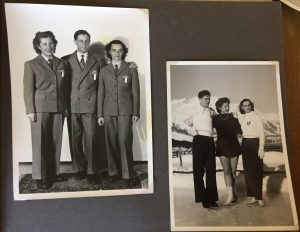
The first photo shows Ciacia, Carlo & Grazia wearing the Italian team uniform.
The second photo shows Carlo & Grazia wearing the white Italian matching outfits, while Ciacia wears a black outfit.
Since Ciacia is wearing skates, the different clothing could be explained as the white outfit being for the pairs figure skaters
The pair skating competition was a little lesser bitter, Carlo and Grazia placed 13th from 15, they probably understood, even at a young age, that their national domination as Italian champions had no value, outside of the country borders
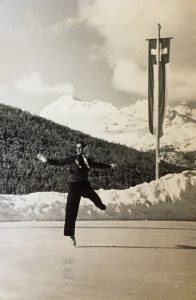
Grazia training in St. Moritz
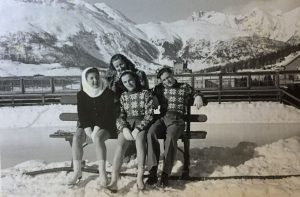
Mrs. Frenssen [standing] with Ciacia, Grazia & Carlo
As usual Grazia & Carlo’s outfit are perfectly matched
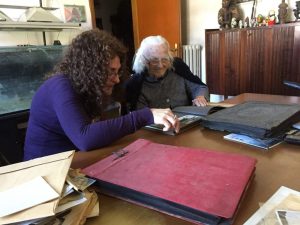
Part 4 of this series explores Grazia’s third or ‘Red Album’ which contains the last years of her career….
The Milanese girl was no longer a teenager, she was a young woman with international experience .. and she probably wanted to break away from her parents’ and coaches’ rules … to explore her peers’ world … Read Part 4 here at Playing Pasts by clicking on the link below
Article © Marco Giani

